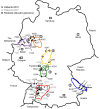Multiple synchronous outbreaks of Puumala virus, Germany, 2010
- PMID: 22932394
- PMCID: PMC3437711
- DOI: 10.3201/eid1809.111447
Multiple synchronous outbreaks of Puumala virus, Germany, 2010
Abstract
To investigate 2,017 cases of hantavirus disease in Germany, we compared 38 new patient-derived Puumala virus RNA sequences identified in 2010 with bank vole-derived small segment RNA sequences. The epidemic process was driven by outbreaks of 6 Puumala virus clades comprising strains of human and vole origin. Each clade corresponded to a different outbreak region.
Figures


Similar articles
-
Hantavirus outbreak, Germany, 2007.Emerg Infect Dis. 2008 May;14(5):850-2. doi: 10.3201/eid1405.071533. Emerg Infect Dis. 2008. PMID: 18439382 Free PMC article. No abstract available.
-
Molecular and epidemiological characteristics of human Puumala and Dobrava-Belgrade hantavirus infections, Germany, 2001 to 2017.Euro Surveill. 2019 Aug;24(32):1800675. doi: 10.2807/1560-7917.ES.2019.24.32.1800675. Euro Surveill. 2019. PMID: 31411134 Free PMC article.
-
Co-circulation of two Puumala hantavirus lineages in Latvia: a Russian lineage described previously and a novel Latvian lineage.J Med Virol. 2012 Feb;84(2):314-8. doi: 10.1002/jmv.22263. J Med Virol. 2012. PMID: 22170553
-
[Increase in the number of cases of epidemic nephropathy in Germany. Virological and ecological aspects].Dtsch Med Wochenschr. 2008 Mar;133(10):476-8. doi: 10.1055/s-2008-1046736. Dtsch Med Wochenschr. 2008. PMID: 18302100 Review. German.
-
[Study on molecular epidemiology of Puumala-like virus].Zhonghua Liu Xing Bing Xue Za Zhi. 2008 Oct;29(10):1045-8. Zhonghua Liu Xing Bing Xue Za Zhi. 2008. PMID: 19173894 Review. Chinese. No abstract available.
Cited by
-
Isolation and characterization of new Puumala orthohantavirus strains from Germany.Virus Genes. 2020 Aug;56(4):448-460. doi: 10.1007/s11262-020-01755-3. Epub 2020 Apr 23. Virus Genes. 2020. PMID: 32328924 Free PMC article.
-
Spatial and Temporal Evolutionary Patterns in Puumala Orthohantavirus (PUUV) S Segment.Pathogens. 2020 Jul 8;9(7):548. doi: 10.3390/pathogens9070548. Pathogens. 2020. PMID: 32650456 Free PMC article.
-
Survey for hantaviruses, tick-borne encephalitis virus, and Rickettsia spp. in small rodents in Croatia.Vector Borne Zoonotic Dis. 2014 Jul;14(7):523-30. doi: 10.1089/vbz.2013.1457. Epub 2014 May 27. Vector Borne Zoonotic Dis. 2014. PMID: 24866325 Free PMC article.
-
[Viral zoonoses in Germany: a One Health perspective].Bundesgesundheitsblatt Gesundheitsforschung Gesundheitsschutz. 2023 Jun;66(6):599-616. doi: 10.1007/s00103-023-03709-0. Epub 2023 Jun 1. Bundesgesundheitsblatt Gesundheitsforschung Gesundheitsschutz. 2023. PMID: 37261460 Free PMC article. Review. German.
-
Host-Associated Absence of Human Puumala Virus Infections in Northern and Eastern Germany.Emerg Infect Dis. 2017 Jan;23(1):83-86. doi: 10.3201/eid2301.160224. Emerg Infect Dis. 2017. PMID: 27983499 Free PMC article.
References
-
- Robert Koch Institut. SurvStat@RKI [cited 2012 Mar 12]. http://www3.rki.de/SurvStat
-
- Faber MS, Ulrich RG, Frank C, Brockmann SO, Pfaff GM, Jacob J, et al. Steep rise in notified hantavirus infections in Germany, April 2010. Euro Surveill. 2010;15:19574. - PubMed
-
- Mailles A, Sin MA, Ducoffre G, Heyman P, Koch J, Zeller H. Larger than usual increase in cases of hantavirus infection in Belgium, France and Germany, June 2005. Euro Surveill. 2005;10:E050721.4. - PubMed
Publication types
MeSH terms
Substances
LinkOut - more resources
Full Text Sources
Molecular Biology Databases
